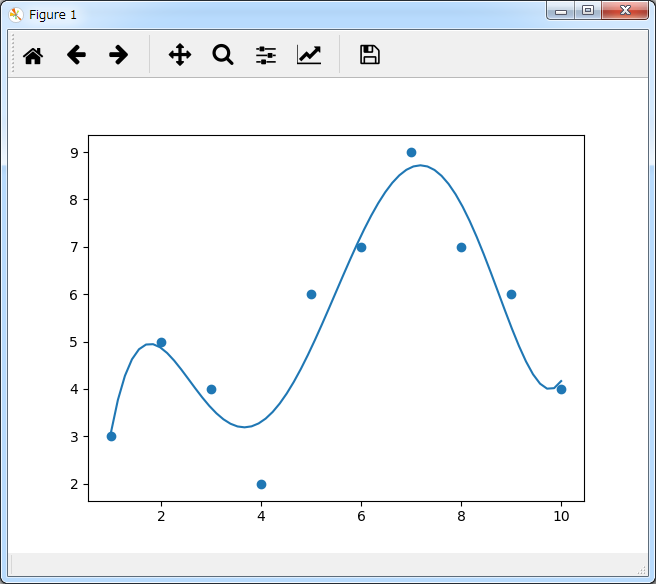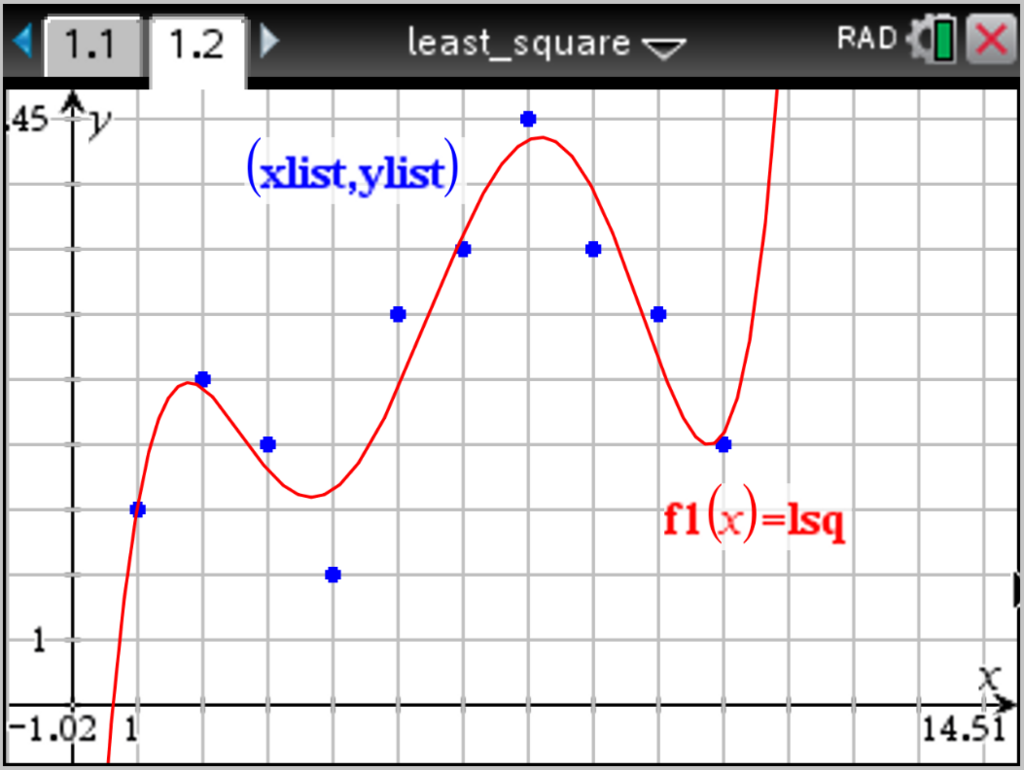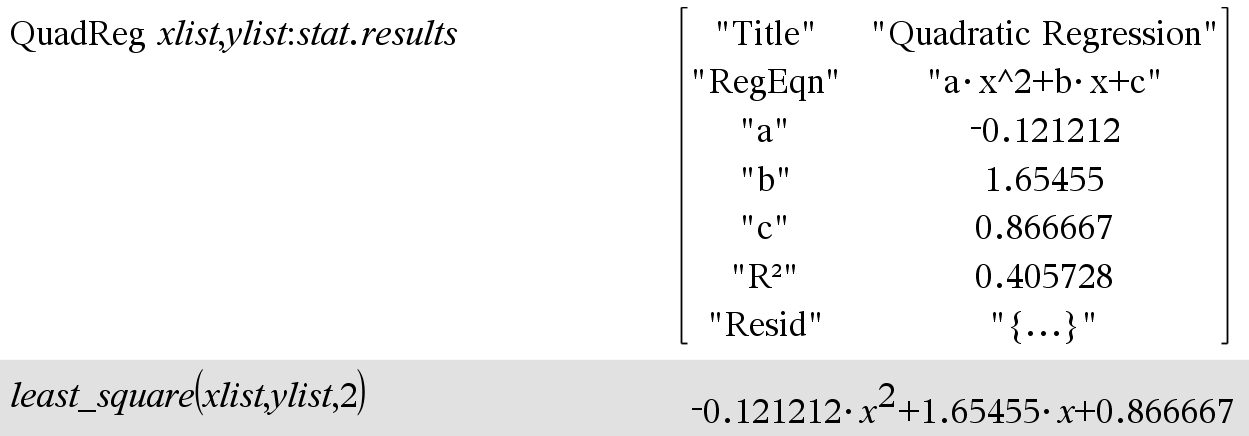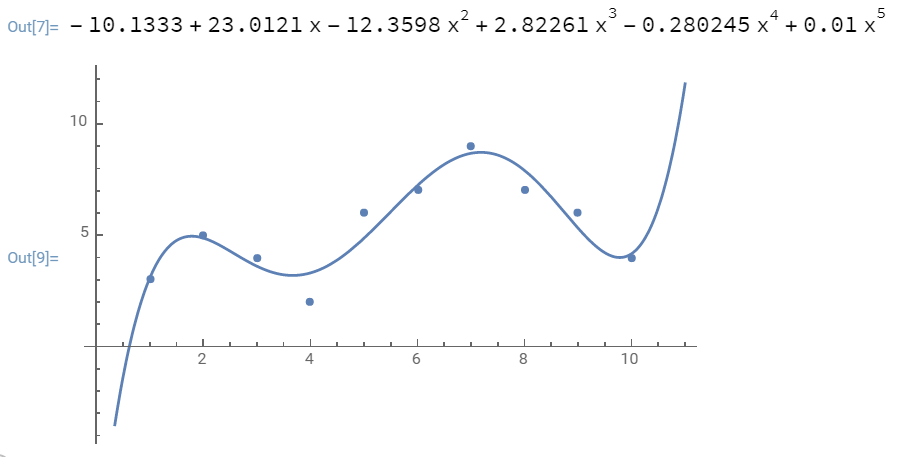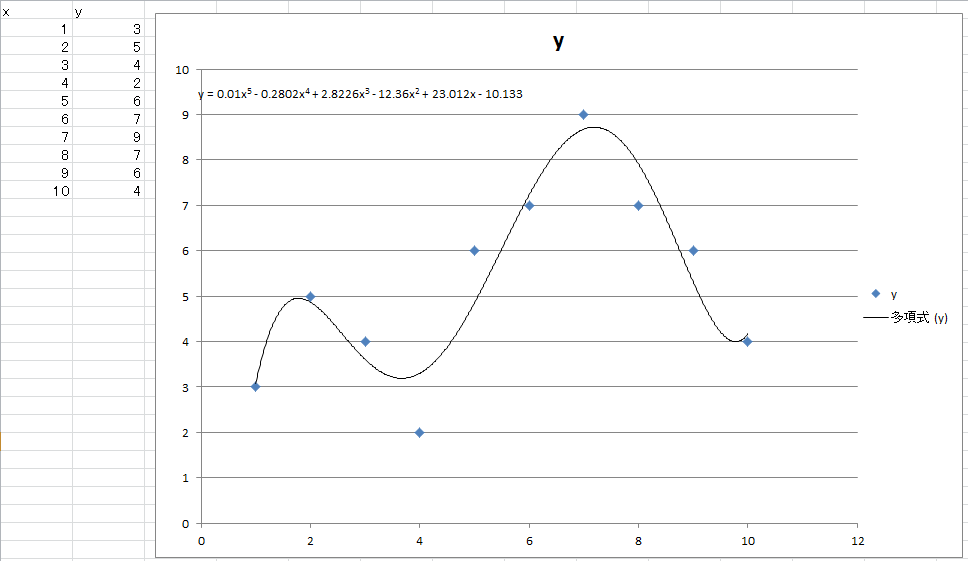参考: 安川章, 「できる人が使っている最小二乗法の一発フィット」,『Interface(インターフェース)』2017年 08 月号(CQ出版), p.143
擬似逆行列を使って求める方法が参考記事に紹介されているのでグラフ電卓 TI-Nspire で再現してみる。
何かを測定して次のデータ対が得られたとする。このデータが N 次函数で近似できるものと假定する。
x = {1,2,3,4,5,6,7,8,9,10}
y = {3,5,4,2,6,7,9,7,6,4}
このデータを次のように行列で表現する。
a = [ [x[0]^N, x[0]^(N-1), ......, x[0]^0],
[x[1]^N, x[1]^(N-1), ......, x[1]^0],
.
.
.
[x[k]^N, x[k]^(N-1), ......, x[k]^0] ]
b = [ [y[0]], [y[1]], ......, [y[k]] ]
coeffs = [ [coeffs[N]], [coeffs[N-1]], ......, [coeffs[0]] ]
a * coeffs = b
未知数 coeffs = b * (a^-1) が N 次近似函数の各次数の係数である。
一般にデータのほうが未知数よりも圧倒的に多いため行列 a は正方行列にはならず逆行列 (a^-1) が求まらない。そこで逆行列の代わりに擬似逆行列を利用する。理窟はわからないがこれで最小二乗法と同じ結果になるとの由。擬似逆行列は次式で求まる。
a の擬似逆行列 = ((a の転置行列) * a)^-1 * (a の転置行列)
グラフ電卓 TI-Nspire (TI Basic) で組んだプログラム:
(.tns ファイル: https://drive.google.com/open?id=1sTE-hB8h4cQ_xC7vn_EQP2B7nA0pxvZC)
Define least_square(xlist, ylist, order)=
Func
:Local a, a_trans, a_pinv, coeffs, poly_func
:a:= seq(seq(xlist[m]^(n), n, order, 0, −1), m, 1, dim(xlist)) © 行列 a を組み立てる。
:a_trans:= a@t © 行列 a の転置行列を求める。
:a_pinv:= (a_trans * a)^(−1) * a_trans © 行列 a の擬似逆行列を求める。
:b:= (list▶mat(ylist))@t © 行列 b を組み立てる。
:coeffs:= a_pinv * b © 擬似逆行列を使って多項式の各次数の係数を求める。
:coeffs:= mat▶list(coeffs)
:poly_func:= polyEval(coeffs, x) © 近似多項式を組み立てて、
:Return approx(poly_func) © 返す。
:EndFunc
`(見る/隠す) 3 次までなら回帰分析用の函数が用意されているのでそれを使ったほうが早い`
`(見る/隠す) Wolfram の場合 (Fit[] 函数を使う)`
xList = {1,2,3,4,5,6,7,8,9,10};
yList = {3,5,4,2,6,7,9,7,6,4};
order = 5;
xyList = Transpose[{xList, yList}]; (* {{x1, y1}, {x2, y2}, ...} に変換する *)
scatPlt = ListPlot[xyList]; (* 点列の散布図 *)
n = Table[x^n, {n, 0, order}];
polyEq = Fit[xyList, n, x] (* 近似多項式を求める *)
polyPlt = Plot[polyEq, {x, 0, 11}]; (* 近似多項式のグラフ *)
Show[polyPlt, scatPlt] (* 点列の散布図と近似多項式のグラフとを一緒に描く *)
`(見る/隠す) Python の場合 (numpy.polyfit() 函数を使う)`
import matplotlib.pyplot as plt
import numpy as np
import sympy as sym
x = sym.Symbol("x")
xList = np.array([1,2,3,4,5,6,7,8,9,10])
yList = np.array([3,5,4,2,6,7,9,7,6,4])
N = 5
coeffs = np.polyfit(xList, yList, N)
print("%s ~ 0 次の係数: %s" % (N, coeffs))
eq = np.poly1d(coeffs)
print("近似多項式: %s" % (sym.expand(eq(x))))
x_numbers = np.linspace(xList[0], xList[-1], 2**6+1)
plt.scatter(xList, yList)
plt.plot(x_numbers, eq(x_numbers))
plt.show()
実行結果:
5 ~ 0 次の係数: [ 1.00000000e-02 -2.80244755e-01 2.82261072e+00 -1.23598485e+01 2.30121445e+01 -1.01333333e+01]
近似多項式: 0.0100000000000009*x**5 - 0.280244755244777*x**4 + 2.82261072261092*x**3 - 12.3598484848493*x**2 + 23.0121445221459*x - 10.1333333333339
